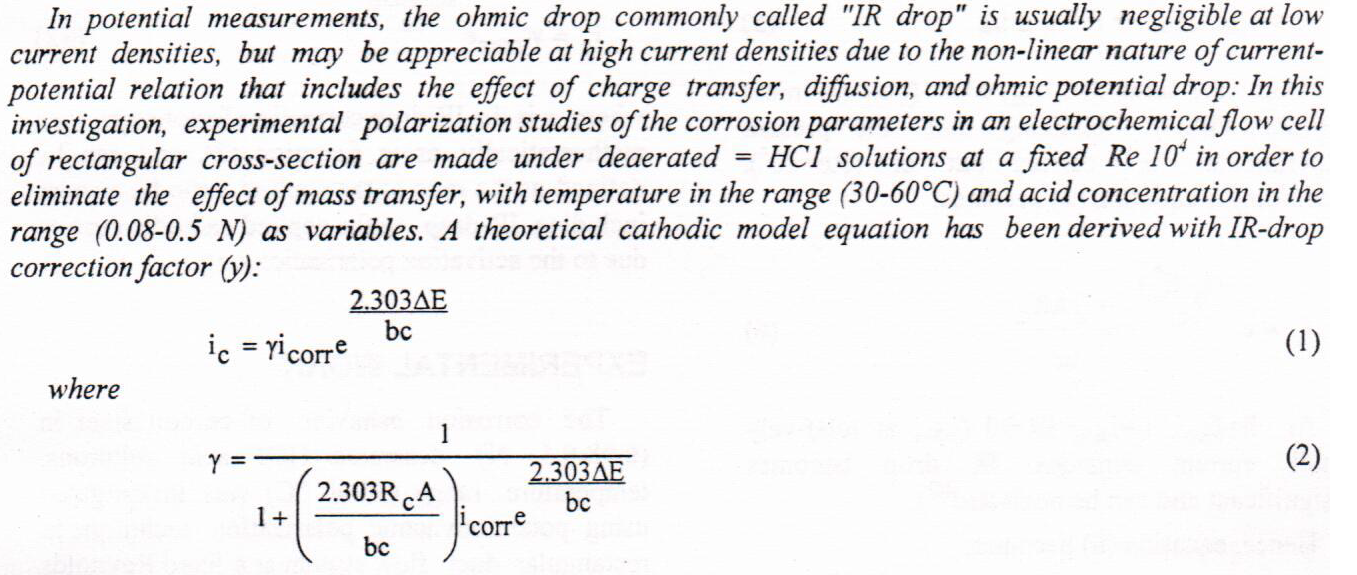
In this paper, construction microwaves induced plasma jet(MIPJ) system. This system was used to produce a non-thermal plasma jet at atmospheric pressure, at standard frequency of 2.45 GHz and microwave power of 800 W. The working gas Argon (Ar) was supplied to flow through the torch with adjustable flow rate by using flow meter, to diagnose microwave plasma optical emission spectroscopy(OES) was used to measure the important plasma parameters such as electron temperature (Te), residence time (Rt), plasma frequency (?pe), collisional skin depth (?), plasma conductivity (?dc), Debye length(?D). Also, the density of the plasma electron is calculated with the use of Stark broadened profiles
 (19)
(19)
 (7)
(7)
The corrosion of carbon steel in single phase (water with 0.1N NaCl ) and two immiscible phases (kerosene-water) using turbulently agitated system is investigated. The experiments are carried out for Reynolds number (Re) range of 38000 to 95000 corresponding to rotational velocities from 600 to 1400 rpm using circular disk turbine agitator at 40 0C. In two-phase system test runs are carried out in aqueous phase (water) concentrations of 1 % vol., 5 % vol., 8% vol., and 16% vol. mixed with kerosene at various Re. The effect of Reynolds number (Re), percent of dispersed phase, dispersed drops diameter, and number of drops per unit volume on the corrosion rate is investigated and discussed. Test runs are carried out using two types of
... Show MoreThis paper presents an experimental and theoretical analysis to investigate the two-phase flow boiling heat transfer coefficient and pressure drop of the refrigerant R-134a in the evaporator test section of the refrigeration system under different operating conditions. The test conditions considered are, for heat flux (13.7-36.6) kW/m2, mass flux (52-105) kg/m2.s, vapor quality (0.2-1) and saturation temperature (-15 to -3.7) ˚C. Experiments were carried out using a test rig for a 310W capacity refrigeration system, which is designed and constructed in the current work. Investigating of the experimental results has revealed that, the enhancement in local heat trans
... Show More (3)
(3)
This piece of research work aims to study one of the most difficult reaction and determination due to continuous and rapid variation of reaction products and the reactants. As molybdenum (VI) aid in the decomposition of hydrogen peroxide in alkaline medium of ammomia, thus means a continuous liberation of oxygen which cuases and in a continuous manner a distraction in the measurement process. On this basis pyrogallol was used to absorbe all liberated oxygen and the result is an a clean undisturbed signals. Molybdenum (VI) was determined in the range of 4-100 ?g.ml-1 with percentage linearity of 99.8% or (4-300 ?g.ml-1 with 94.4%) while L.O.D. was 3.5 ?g.ml-1. Interferring ions (cations and anions) were studied and their main effect was red
... Show MorePhenol condensed with β-keto esters via Pechmann condensation to form derivatives of Coumarin in various reaction conditions by two ways. Present paper is comparative study of synthesis Coumarin with the yield of product , reaction time and reaction conditions.
 (2)
(2)
 (1)
(1)
This investigation is a study of the length of time where drops can exist at an oil-water interface before coalescence take place with a bulk of the same phase as the drops. Many factors affecting the time of coalescence were studied in is investigation which included: dispersed phase flow rate, continuous phase height, hole size in distributor, density difference between phases, and viscosity ratio of oil/water systems, employing three liquid/liquid systems; kerosene/water, gasoil/water, and hexane/water. Higher value of coalescence time was 8.26 s at 0.7ml/ s flow rate, 30cm height and 7mm diameter of hole for gas oil/water system, and lower value was 0.5s at 0.3ml/s flow rate, 10 cm height and 3mm diameter of hole for hexane
... Show MoreThis work presents a five-period chaotic system called the Duffing system, in which the effect of changing the initial conditions and system parameters d, g and w, on the behavior of the chaotic system, is studied. This work provides a complete analysis of system properties such as time series, attractors, and Fast Fourier Transformation Spectrum (FFT). The system shows periodic behavior when the initial conditions xi and yi equal 0.8 and 0, respectively, then the system becomes quasi-chaotic when the initial conditions xi and yi equal 0 and 0, and when the system parameters d, g and w equal 0.02, 8 and 0.09. Finally, the system exhibits hyperchaotic behavior at the first two conditions, 0 and 0, and the bandwidth of the chaotic
... Show More (2)
(2)

